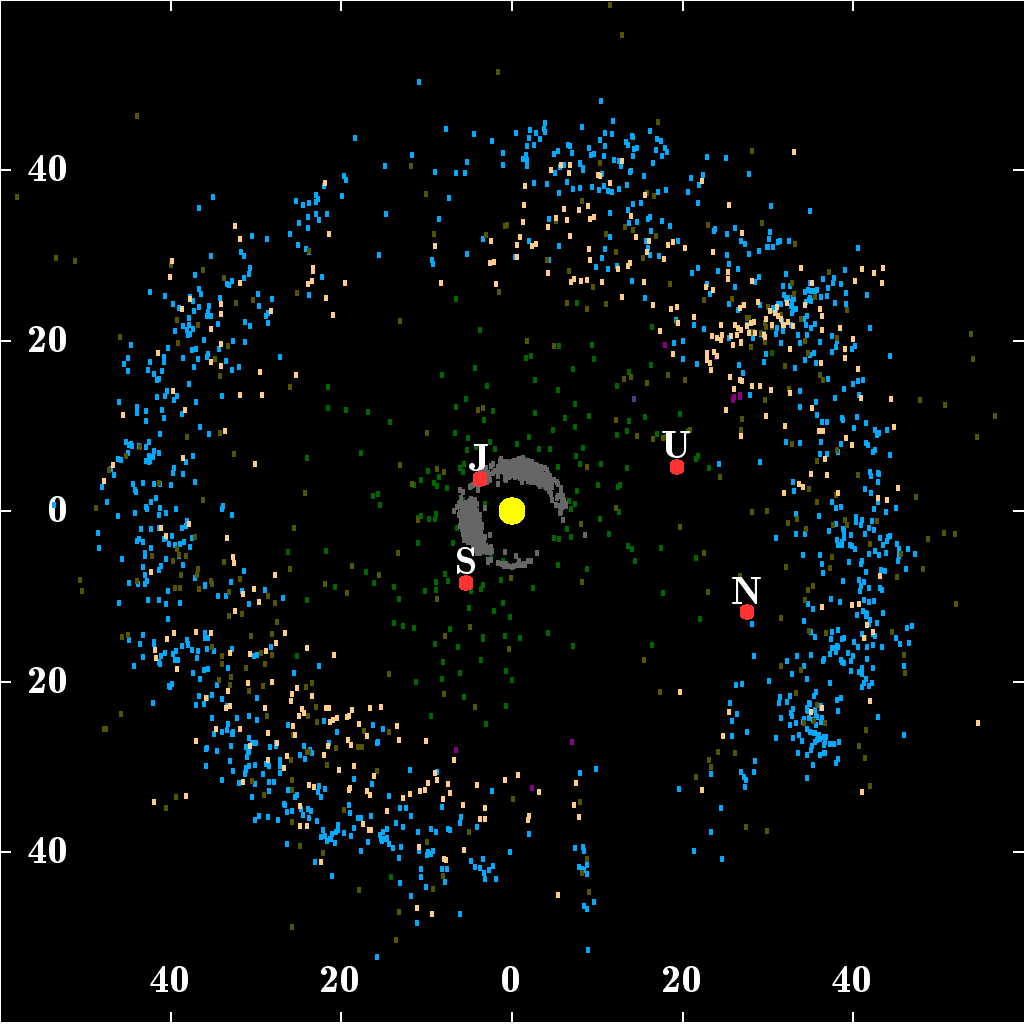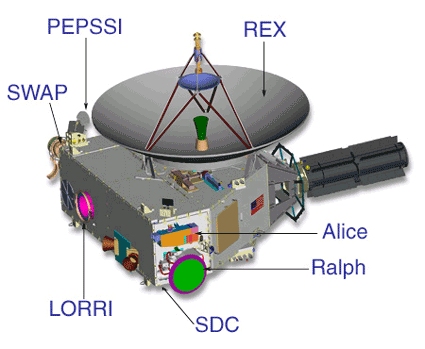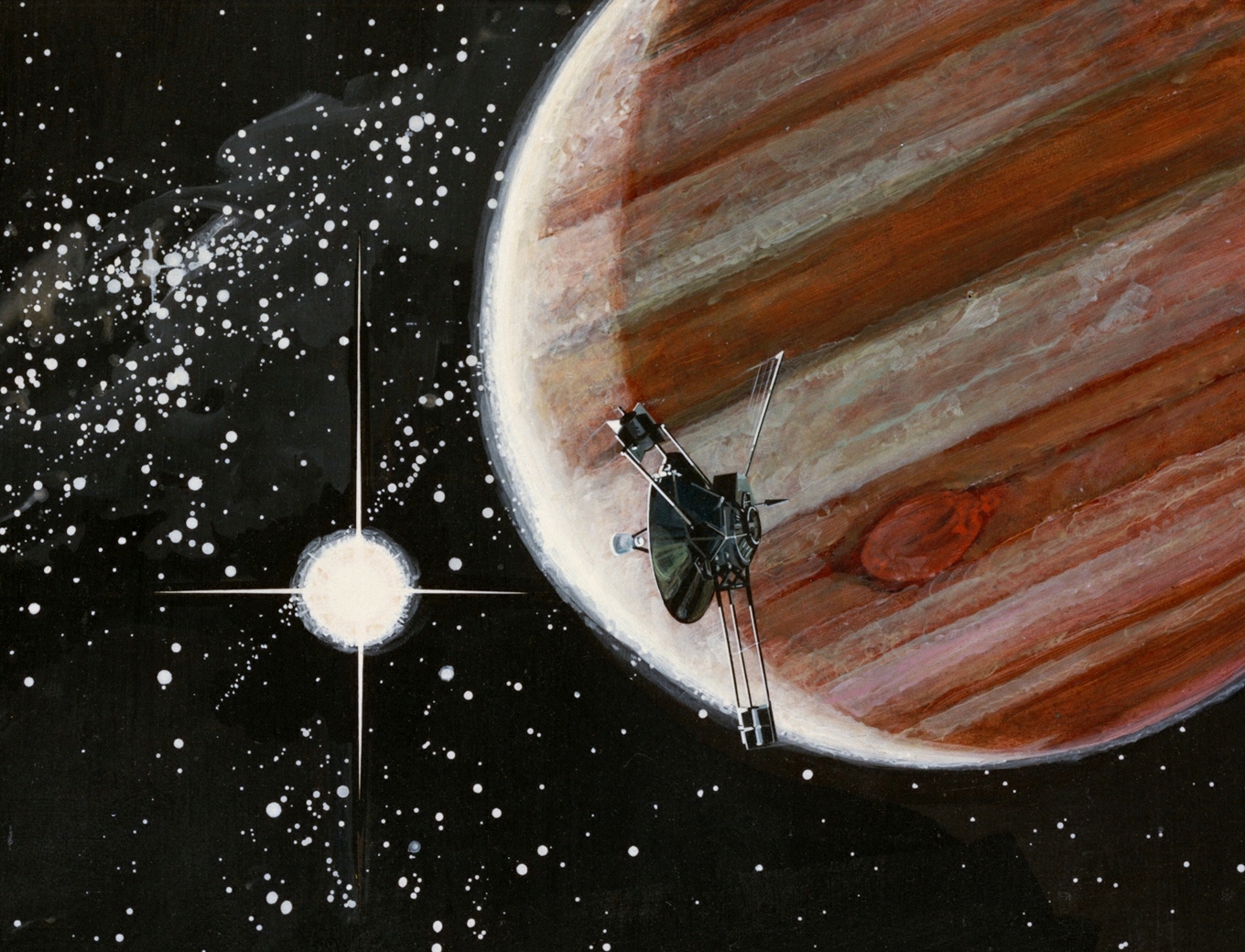|
Interplanetary Dust Cloud
The interplanetary dust cloud, or zodiacal cloud (as the source of the zodiacal light), consists of cosmic dust (small particles floating in outer space) that pervades the space between planets within planetary systems, such as the Solar System. This system of particles has been studied for many years in order to understand its nature, origin, and relationship to larger bodies. There are several methods to obtain space dust measurement. In the Solar System, the interplanetary dust particles have a role in scattering sunlight and in emitting thermal radiation, which is the most prominent feature of the night sky's radiation, with wavelengths ranging 5–50 μm. The particle sizes of grains characterizing the infrared emission near Earth's orbit typically range 10–100 μm. Microscopic impact craters on lunar rocks returned by the Apollo Program revealed the size distribution of cosmic dust particles bombarding the lunar surface. The ’’Grün’’ distribution of interpl ... [...More Info...] [...Related Items...] OR: [Wikipedia] [Google] [Baidu] |
Earth's Orbit
Earth orbits the Sun at an average distance of 149.60 million km (92.96 million mi) in a counterclockwise direction as viewed from above the Northern Hemisphere. One complete orbit takes days (1 sidereal year), during which time Earth has traveled 940 million km (584 million mi). Jean Meeus, ''Astronomical Algorithms'' 2nd ed, (Richmond, VA: Willmann-Bell, 1998) 238. See Ellipse#Circumference. The formula by Ramanujan is accurate enough. Ignoring the influence of other Solar System bodies, Earth's orbit is an ellipse with the Earth-Sun barycenter as one focus and a current eccentricity of 0.0167. Since this value is close to zero, the center of the orbit is relatively close to the center of the Sun (relative to the size of the orbit). As seen from Earth, the planet's orbital prograde motion makes the Sun appear to move with respect to other stars at a rate of about 1° eastward per solar day (or a Sun or Moon diameter every 12 hours).Our planet takes about 36 ... [...More Info...] [...Related Items...] OR: [Wikipedia] [Google] [Baidu] |
Interstellar Medium
In astronomy, the interstellar medium is the matter and radiation that exist in the space between the star systems in a galaxy. This matter includes gas in ionic, atomic, and molecular form, as well as dust and cosmic rays. It fills interstellar space and blends smoothly into the surrounding intergalactic space. The energy that occupies the same volume, in the form of electromagnetic radiation, is the interstellar radiation field. The interstellar medium is composed of multiple phases distinguished by whether matter is ionic, atomic, or molecular, and the temperature and density of the matter. The interstellar medium is composed, primarily, of hydrogen, followed by helium with trace amounts of carbon, oxygen, and nitrogen. The thermal pressures of these phases are in rough equilibrium with one another. Magnetic fields and turbulent motions also provide pressure in the ISM, and are typically more important, dynamically, than the thermal pressure is. In the interstellar medium, ... [...More Info...] [...Related Items...] OR: [Wikipedia] [Google] [Baidu] |
Kuiper Belt
The Kuiper belt () is a circumstellar disc in the outer Solar System, extending from the orbit of Neptune at 30 astronomical units (AU) to approximately 50 AU from the Sun. It is similar to the asteroid belt, but is far larger—20 times as wide and 20–200 times as massive. Like the asteroid belt, it consists mainly of small bodies or remnants from when the Solar System formed. While many asteroids are composed primarily of rock and metal, most Kuiper belt objects are composed largely of frozen volatiles (termed "ices"), such as methane, ammonia, and water. The Kuiper belt is home to most of the objects that astronomers generally accept as dwarf planets: Orcus, Pluto, Haumea, Quaoar, and Makemake. Some of the Solar System's moons, such as Neptune's Triton and Saturn's Phoebe, may have originated in the region. The Kuiper belt was named after Dutch astronomer Gerard Kuiper, although he did not predict its existence. In 1992, minor planet (15760) Albion was ... [...More Info...] [...Related Items...] OR: [Wikipedia] [Google] [Baidu] |
Comet
A comet is an icy, small Solar System body that, when passing close to the Sun, warms and begins to release gases, a process that is called outgassing. This produces a visible atmosphere or coma, and sometimes also a tail. These phenomena are due to the effects of solar radiation and the solar wind acting upon the nucleus of the comet. Comet nuclei range from a few hundred meters to tens of kilometers across and are composed of loose collections of ice, dust, and small rocky particles. The coma may be up to 15 times Earth's diameter, while the tail may stretch beyond one astronomical unit. If sufficiently bright, a comet may be seen from Earth without the aid of a telescope and may subtend an arc of 30° (60 Moons) across the sky. Comets have been observed and recorded since ancient times by many cultures and religions. Comets usually have highly eccentric elliptical orbits, and they have a wide range of orbital periods, ranging from several years to potentially several mill ... [...More Info...] [...Related Items...] OR: [Wikipedia] [Google] [Baidu] |
New Horizons
''New Horizons'' is an Interplanetary spaceflight, interplanetary space probe that was launched as a part of NASA's New Frontiers program. Engineered by the Johns Hopkins University Applied Physics Laboratory (APL) and the Southwest Research Institute (SwRI), with a team led by Alan Stern, the spacecraft was launched in 2006 with the primary mission to perform a Planetary flyby, flyby study of the Pluto system in 2015, and a secondary mission to fly by and study one or more other Kuiper belt objects (KBOs) in the decade to follow, which became a mission to 486958 Arrokoth. It is the List of artificial objects leaving the Solar System, fifth space probe to achieve the escape velocity needed to leave the Solar System. On January 19, 2006, ''New Horizons'' was launched from Cape Canaveral Space Force Station by an Atlas V rocket directly into an Earth-and-solar Escape velocity, escape trajectory with a speed of about . It was the fastest (average speed with respect to Earth) man ... [...More Info...] [...Related Items...] OR: [Wikipedia] [Google] [Baidu] |
Venetia Burney Student Dust Counter
The Venetia Burney Student Dust Counter (VBSDC) is a scientific instrument aboard the unmanned ''New Horizons'' space probe that is designed to detect dust impacts in outer space. VBSDC is the first planetary science instrument to be built by students. The dust counter was launched in 2006, and named later that year after Venetia Burney, the young girl who originally named Pluto. The detector works when dust strikes films of polarized polyvinylidene fluoride (PVDF), which generates an electrical charge. The space dust is then detected over the course of the ''New Horizons'' spacecraft flight out of the Solar System and past Pluto. Overview In 2010, VBSDC collected data on dust past 18 AU (1.67 billion miles), which is the distance the ''Pioneer 10'' and ''Pioneer 11'' dust counters stopped working. Five other spacecraft have carried dust detectors beyond the asteroid belt including ''Pioneer 10'', ''Pioneer 11'', ''Ulysses'' (heliocentric orbit out to the distance of Jupiter), ... [...More Info...] [...Related Items...] OR: [Wikipedia] [Google] [Baidu] |
Pioneer 10
''Pioneer 10'' (originally designated Pioneer F) is an American space probe, launched in 1972 and weighing , that completed the first mission to the planet Jupiter. Thereafter, ''Pioneer 10'' became the first of five artificial objects to achieve the escape velocity needed to leave the Solar System. This space exploration project was conducted by the NASA Ames Research Center in California. The space probe was manufactured by TRW Inc. ''Pioneer 10'' was assembled around a hexagonal bus with a diameter parabolic dish high-gain antenna, and the spacecraft was spin stabilized around the axis of the antenna. Its electric power was supplied by four radioisotope thermoelectric generators that provided a combined 155 watts at launch. It was launched on March 3, 1972, at 01:49:00 UTC (March 2 local time), by an Atlas-Centaur expendable vehicle from Cape Canaveral, Florida. Between July 15, 1972, and February 15, 1973, it became the first spacecraft to traverse the asteroid belt. ... [...More Info...] [...Related Items...] OR: [Wikipedia] [Google] [Baidu] |
Twilight
Twilight is light produced by sunlight scattering in the upper atmosphere, when the Sun is below the horizon, which illuminates the lower atmosphere and the Earth's surface. The word twilight can also refer to the periods of time when this illumination occurs. The lower the Sun is beneath the horizon, the dimmer the twilight (other factors such as atmospheric conditions being equal). When the Sun reaches 18° below the horizon, the twilight's brightness is nearly zero, and evening twilight becomes nighttime. When the Sun again reaches 18° below the horizon, nighttime becomes morning twilight. Owing to its distinctive quality, primarily the absence of shadows and the appearance of objects silhouetted against the lit sky, twilight has long been popular with photographers and painters, who often refer to it as the blue hour, after the French expression ''l'heure bleue''. By analogy with evening twilight, the word ''twilight'' is also sometimes used metaphorically, to imply tha ... [...More Info...] [...Related Items...] OR: [Wikipedia] [Google] [Baidu] |
Ecliptic
The ecliptic or ecliptic plane is the orbital plane of the Earth around the Sun. From the perspective of an observer on Earth, the Sun's movement around the celestial sphere over the course of a year traces out a path along the ecliptic against the background of stars. The ecliptic is an important reference plane and is the basis of the ecliptic coordinate system. Sun's apparent motion The ecliptic is the apparent path of the Sun throughout the course of a year. Because Earth takes one year to orbit the Sun, the apparent position of the Sun takes one year to make a complete circuit of the ecliptic. With slightly more than 365 days in one year, the Sun moves a little less than 1° eastward every day. This small difference in the Sun's position against the stars causes any particular spot on Earth's surface to catch up with (and stand directly north or south of) the Sun about four minutes later each day than it would if Earth did not orbit; a day on Earth is therefore 24 hours ... [...More Info...] [...Related Items...] OR: [Wikipedia] [Google] [Baidu] |
Zodiac
The zodiac is a belt-shaped region of the sky that extends approximately 8° north or south (as measured in celestial latitude) of the ecliptic, the Sun path, apparent path of the Sun across the celestial sphere over the course of the year. The paths of the Moon and visible planets are within the belt of the zodiac. In Western astrology, and formerly astronomy, the zodiac is divided into astrological sign, twelve signs, each occupying 30° of celestial longitude and roughly corresponding to the following star constellations: Aries (astrology), Aries, Taurus (astrology), Taurus, Gemini (astrology), Gemini, Cancer (astrology), Cancer, Leo (astrology), Leo, Virgo (astrology), Virgo, Libra (astrology), Libra, Scorpio (astrology), Scorpio, Sagittarius (astrology), Sagittarius, Capricorn (astrology), Capricorn, Aquarius (astrology), Aquarius, and Pisces (astrology), Pisces. These astrological signs form a celestial coordinate system, or more specifically an ecliptic coordinate sys ... [...More Info...] [...Related Items...] OR: [Wikipedia] [Google] [Baidu] |




.jpg)




